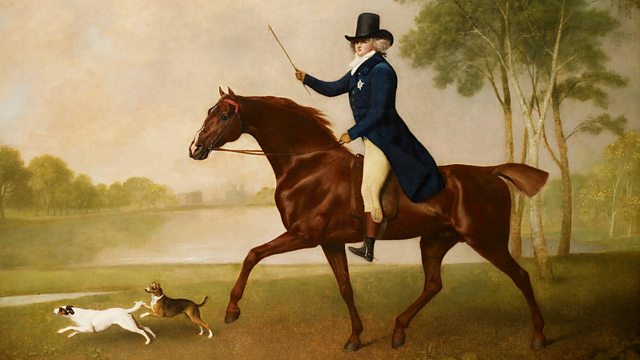Art, Passion & Power – The Story of the Royal Collection episode 3: Andrew Graham-Dixon continues his exploration of the Royal Collection, the vast collection of art and decorative objects owned by the Queen. In the third episode he has reached the age of the Romantics – the flamboyant George IV who created so much of the visual look of the modern monarchy, and Queen Victoria and Prince Albert, for whom collecting was an integral part of their happy marriage.
As Prince of Wales, George was a famously loose cannon – a spendaholic prince whose debts ballooned in tandem with the royal waistline. But as a collector, Andrew argues, George was one of the great artistic figures of the Romantic age. His tastes were very much formed by the fallout from the French Revolution; as the great French aristocratic collections were broken up, an exodus of great art flooded into London’s auction rooms – and George was there to buy them. He assembled a world-class collection of Dutch and Flemish masters, including key works by Rembrandt, Cuyp and de Hooch, as well as some of the greatest examples of French furniture ever produced, which Andrew sees in the state rooms of Buckingham Palace.
Art, Passion & Power – The Story of the Royal Collection episode 3
George IV was a natural showman and Andrew argues that his visit to Edinburgh in 1822 helped pioneer the modern monarchy’s use of spectacle. But, like Henry VIII and Charles before him, George had the sense to partner up with an artist of genius – Sir Thomas Lawrence. The result of their collaboration is seen in a series of stirring battlefield portraits that line Windsor Castle’s Waterloo Chamber.
Queen Victoria is often depicted as the uptight opposite of her louche uncle, but Andrew argues that, for her, art was just as important. This was a passion that she could share with her beloved husband, Prince Albert, who believed that learning how to make art was the best way to understand it.
Andrew visits Osborne House on the Isle of Wight, still filled with their art possessions, including marble facsimiles of the arms and legs of her infant children, commissioned by Victoria herself.
Andrew argues that Albert was a natural curator; he instilled a love for collecting in his children and compiled an early ‘database’ of the complete works of Raphael which he kept in his new ‘print room’ in Windsor Castle as a tool for art historians. But it is on the streets of South Kensington (‘Albertopolis’) that Andrew discovers Albert’s real legacy – the museums and educational institutions here are a testimony to his vision for the area, purchased with the help of profits from the Great Exhibition.
Royal Collection
The Royal Collection of the British royal family is the largest private art collection in the world.
Spread among 13 occupied and historic royal residences in the United Kingdom, the collection is owned by Elizabeth II and overseen by the Royal Collection Trust. The Queen owns some of the collection in right of the Crown and some as a private individual. It is made up of over one million objects, including 7,000 paintings, over 150,000 works on paper, this including 30,000 watercolours and drawings, and about 450,000 photographs, as well as tapestries, furniture, ceramics, textiles, carriages, weapons, armour, jewellery, clocks, musical instruments, tableware, plants, manuscripts, books, and sculptures.
Some of the buildings which house the collection, like Hampton Court Palace, are open to the public and not lived in by the Royal Family, whilst others, like Windsor Castle and Kensington Palace, are both residences and open to the public. The Queen’s Gallery at Buckingham Palace in London was built specially to exhibit pieces from the collection on a rotating basis. There is a similar art gallery next to the Palace of Holyroodhouse in Edinburgh, and a Drawings Gallery at Windsor Castle. The Crown Jewels are on public display in the Jewel House at the Tower of London.
About 3,000 objects are on loan to museums throughout the world, and many others are lent on a temporary basis to exhibitions.
